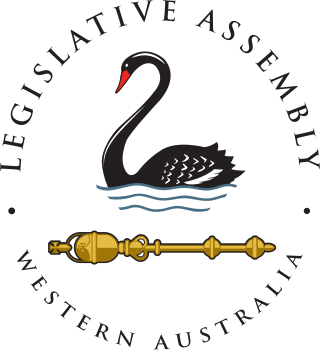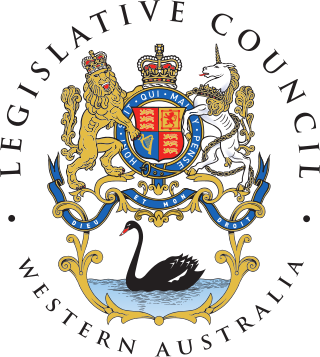
The Western Australian Legislative Assembly, or lower house, is one of the two chambers of the Parliament of Western Australia, an Australian state. The Parliament sits in Parliament House in the Western Australian capital, Perth.

The Western Australian Legislative Council is the upper house of the Parliament of Western Australia, a state of Australia. It is regarded as a house of review for legislation passed by the Legislative Assembly, the lower house. The two Houses of Parliament sit in Parliament House in the state capital, Perth.

Albany is a Legislative Assembly electorate in the state of Western Australia. Albany is named for the port and regional city of Western Australia which falls within its borders. It is one of the oldest electorates in Western Australia, with its first member having been elected in the inaugural 1890 elections of the Legislative Assembly. It is regarded as a swinging seat, and has been held by the Labor Party since the 2001 election, at which Peter Watson was first elected. Watson announced his retirement prior to the 2021 election and was succeeded in the seat by Labor Party colleague, Rebecca Stephens.

The electoral district of Pilbara is a Legislative Assembly electorate in the state of Western Australia. Pilbara is named for the region of Western Australia in which it is located. It is one of the oldest electorates in Western Australia, with its first member having been elected to the Second Parliament of the Legislative Assembly at the 1894 elections.

The Agricultural Region is a multi-member electoral region of the Western Australian Legislative Council, located in the South West, Peel and part of the Great Southern regions of the state. It was created by the Acts Amendment Act 1987, and became effective on 22 May 1989 with five members who had been elected at the 1989 state election three months earlier. At the 2008 election, it was increased to six members.

The East Metropolitan Region is a multi-member electoral region of the Western Australian Legislative Council, located in the eastern and south-eastern suburbs of Perth. It was created by the Acts Amendment Act 1987, and became effective on 22 May 1989 with five members who had been elected at the 1989 state election three months earlier. At the 2008 election, it was increased to six members.

The Mining and Pastoral Region is a multi-member electoral region of the Western Australian Legislative Council, located in the northern and eastern regions of the state. It was created by the Acts Amendment Act 1987, and became effective on 22 May 1989 with five members who had been elected at the 1989 state election three months earlier. At the 2008 election, it was increased to six members.

The North Metropolitan Region is a multi-member electoral region of the Western Australian Legislative Council, located in the north-western and western suburbs of Perth. It was created by the Acts Amendment Act 1987, and became effective on 22 May 1989 with seven members who had been elected at the 1989 state election three months earlier. At the 2008 election, it was decreased to six members.

The South Metropolitan Region is a multi-member electoral region of the Western Australian Legislative Council, located in the southern suburbs of Perth, Western Australia. It was created by the Acts Amendment Act 1987, and became effective on 22 May 1989 with five members who had been elected at the 1989 state election three months earlier. At the 2008 election, it was increased to six members.

The South West Region is a multi-member electoral region of the Western Australian Legislative Council the South West, Peel and part of the Great Southern regions of the state. It was created by the Acts Amendment Act 1987, and became effective on 22 May 1989 with seven members who had been elected at the 1989 state election three months earlier. At the 2008 election, it was reduced to six members. The region includes the cities of Albany, Bunbury and Mandurah.

The 2008 Western Australian state election was held on Saturday 6 September 2008 to elect 59 members to the Legislative Assembly and 36 members to the Legislative Council. The incumbent centre-left Labor Party government, in power since the 2001 election and led since 25 January 2006 by Premier Alan Carpenter, was defeated by the centre-right Liberal Party opposition, led by Opposition Leader Colin Barnett since 6 August 2008.

Jandakot is an electoral district of the Legislative Assembly in the Australian state of Western Australia.
Elections were held in the state of Western Australia on 4 February 1989 to elect all 57 members to the Legislative Assembly and all 34 members to the Legislative Council. The Labor government, led by Premier Peter Dowding, won a third term in office against the Liberal Party, led by Opposition Leader Barry MacKinnon.

Kalamunda is an electoral district of the Legislative Assembly in the Australian state of Western Australia.
The North Central Metropolitan Province was a two-member electoral province of the Western Australian Legislative Council, located in metropolitan Perth. It was created by a redistribution in 1982, and took effect on 22 May 1983 following the 1983 state election. It was formed from parts of the North Metropolitan and North-East Metropolitan provinces, and was a safe Labor seat.
The South Central Metropolitan Province was a two-member electoral province of the Western Australian Legislative Council, located in metropolitan Perth. It was created by a redistribution in 1982, and took effect on 22 May 1983 following the 1983 state election. It was formed from parts of the South Metropolitan and South-East Metropolitan provinces, and was a safe Liberal seat.

Members of the Victorian Legislative Council, the upper house of the Parliament of the Australian State of Victoria, are elected from eight multi-member electorates called regions. The Legislative Council has 40 members, five from each of the eight regions.

The 2017 Western Australian state election was held on Saturday 11 March 2017 to elect members to the Parliament of Western Australia, including all 59 seats in the Legislative Assembly and all 36 seats in the Legislative Council. The eight-and-a-half-year two-term incumbent Liberal–WA National government, led by Premier Colin Barnett, was defeated in a landslide by the Labor opposition, led by Opposition Leader Mark McGowan.

The 2021 Western Australian state election was conducted on Saturday 13 March 2021 to elect members to the Parliament of Western Australia, where all 59 seats in the Legislative Assembly and all 36 seats in the Legislative Council were up for election.

The 2025 Western Australian state election is scheduled to be held on 8 March 2025 to elect members to the Parliament of Western Australia, where all 59 seats in the Legislative Assembly and all 37 seats in the Legislative Council will be up for election.
















